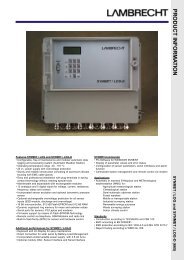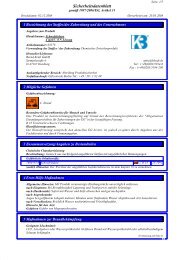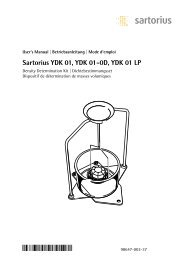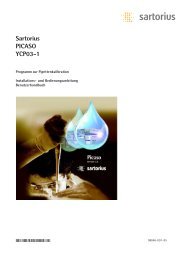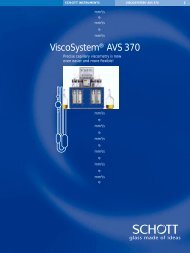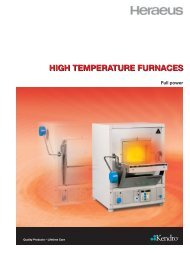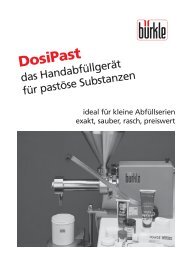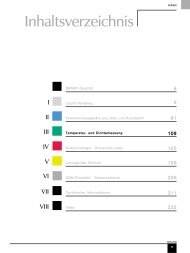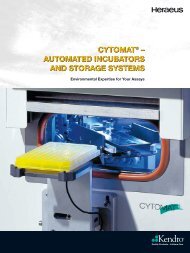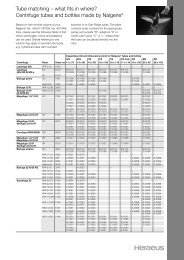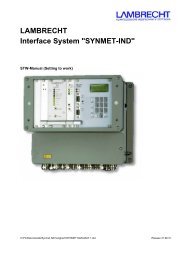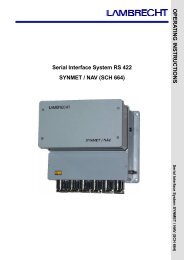ViscoSystem AVS - Windaus
ViscoSystem AVS - Windaus
ViscoSystem AVS - Windaus
You also want an ePaper? Increase the reach of your titles
YUMPU automatically turns print PDFs into web optimized ePapers that Google loves.
SCHOTT INSTRUMENTS<br />
mm 2 /s<br />
r<br />
mm2 /s<br />
r<br />
mm2 /s<br />
r<br />
mm2 /s<br />
r<br />
mm2 /s<br />
<strong>ViscoSystem</strong> ®<br />
<strong>AVS</strong><br />
Viscosity measuring systems suitable<br />
for every user’s application<br />
mm 2 /s<br />
r<br />
mm2 /s<br />
r<br />
mm2 /s<br />
r<br />
mm2 /s<br />
r<br />
mm2 /s<br />
r<br />
mm2 /s<br />
r<br />
mm2 /s<br />
VISCOSYSTEM ®<br />
<strong>AVS</strong>
Contents Page<br />
<strong>ViscoSystem</strong> ® 3<br />
<strong>ViscoSystem</strong> ® <strong>AVS</strong> 350 4<br />
<strong>ViscoSystem</strong> ® <strong>AVS</strong> 360 5<br />
WinVisco 8<br />
<strong>ViscoSystem</strong> ® <strong>AVS</strong> 450 10<br />
Transparent thermostats 12<br />
Flow-through cooler 15<br />
Measurement stands 15<br />
Order information 16<br />
This entire measurement system<br />
comprises the individual components<br />
<strong>AVS</strong> 350/360, thermostat CT 54,<br />
measurement stands and viscometers.<br />
<strong>ViscoSystem</strong> ® <strong>AVS</strong> 350, 360, 450<br />
Method of measurement<br />
The most accurate method to<br />
determine the viscosity of liquids<br />
is by using viscometers.<br />
The <strong>ViscoSystem</strong> ® range uses<br />
this method. What is actually<br />
measured is the time a defined<br />
volume of liquid requires to<br />
flow through a capillary tube of<br />
a specific length and width.<br />
Units of the <strong>ViscoSystem</strong> ® range<br />
can measure flow-through<br />
times with an accuracy of<br />
0.01 %.<br />
In all devices, the liquid meniscus<br />
in the viscometer can be<br />
measured in two different ways:<br />
opto-electronically or using<br />
TC sensors.<br />
Where as the optical system<br />
recognizes the liquid meniscus<br />
using optical fibres, the TC viscometers<br />
utilize the effect of<br />
different thermal conductivity<br />
of air and fluids.<br />
3
<strong>ViscoSystem</strong> ® <strong>AVS</strong> 350:<br />
from a single measuring station to a PC-controlled<br />
sample station with 8 samples<br />
The <strong>ViscoSystem</strong> ® <strong>AVS</strong> 350 viscosity<br />
measuring unit determines<br />
the flow times of liquids<br />
in capillary viscometers with<br />
crystal accuracy and a resolution<br />
of 0.01 s. Because it can<br />
utilize two different sensory systems<br />
(opto-electronically or TC<br />
sensors) for meniscus detection,<br />
the <strong>AVS</strong> 350 system is suitable<br />
for an extremely wide range of<br />
applications and enables transparent,black<br />
or even completely<br />
opaque liquids to be measured.<br />
The <strong>ViscoSystem</strong> ®<br />
<strong>AVS</strong> 350 automatically<br />
repeats the measurements<br />
and saves the measured values.<br />
Not only can it be installed as a<br />
stand-alone device, it can also<br />
be connected to a PC.<br />
A total of 8 units can be linked<br />
together in a daisy chain to<br />
only one RS-232C interface.<br />
Measurement operation and<br />
data evaluation are then controlled<br />
by the computer allowing<br />
the units to operate parallel.<br />
The available PC software Win-<br />
Visco is both versatile and user<br />
friendly. It allows the control<br />
and evaluation of up to 8<br />
<strong>ViscoSystem</strong> ® <strong>AVS</strong> 350 units.<br />
The single measuring<br />
station<br />
<strong>ViscoSystem</strong> ® <strong>AVS</strong> 350 is the<br />
inexpensive starter model for<br />
automatic viscosity measurements<br />
of black liquids using TC<br />
viscometers. If opto-electronic<br />
sensors are preferred, the<br />
appropriate measuring stand is<br />
used.<br />
The <strong>AVS</strong> 350 is easy<br />
to operate as the<br />
automatic sequence of the<br />
measuring process reliably eliminates<br />
subjective error sources.<br />
Measurements are initiated by<br />
pressing a button and the rest<br />
is automatic. After the pre-set<br />
temperature equilibration time<br />
has elapsed, the specified number<br />
of measurements are carried<br />
out. The measured values<br />
are displayed digitally and<br />
saved in the unit’s memory. At<br />
the touch of a button, all values<br />
of a measurement sequence<br />
can be viewed in a scrolling<br />
mode and are available until<br />
the start of a new measurement<br />
series.<br />
The automatic viscometer<br />
cleaner <strong>AVS</strong> 26 cleans and dries<br />
the viscometer after a measurement<br />
series without removing<br />
from the thermostat bath.<br />
Usually the single station works<br />
without being connected to a<br />
PC. However, upon request, the<br />
<strong>AVS</strong> 350 can be controlled by<br />
a PC which then also evaluates<br />
the measurement results.<br />
The multiple sample measuring<br />
station – PC controlled<br />
multi-tasking<br />
When up to 8 units are connected,<br />
the measurements for a<br />
number of samples – both<br />
black and transparent – can be<br />
taken in parallel, either all the<br />
identical ones together or all<br />
samples in a random sequence,<br />
then the results can be evaluated<br />
and documented.<br />
A PC can be used to control<br />
and evaluate the measurements.<br />
The Schott Software<br />
WinVisco supports fast viscosity<br />
measurements, calculations and<br />
their documentation. Users<br />
without any previous computer<br />
experience can learn to use<br />
the programme quickly and<br />
easily. More details are available<br />
on pages 8 and 9.<br />
Hardware and software of the<br />
<strong>ViscoSystem</strong>s ® <strong>AVS</strong> 350 combine<br />
ease of use in the laboratory<br />
with Schott’s experience<br />
in capillary viscometry.<br />
<strong>ViscoSystem</strong> ® <strong>AVS</strong> 360.<br />
Vacuum for accurate results<br />
A high degree of safety<br />
with critical and highly<br />
viscous samples<br />
The viscometers <strong>ViscoSystem</strong> ®<br />
<strong>AVS</strong> 350 and <strong>ViscoSystem</strong> ® <strong>AVS</strong><br />
360 use the same methods of<br />
measurement, measuring in<br />
capillary viscometers. This is the<br />
most accurate method for<br />
determining the viscosity of<br />
Newtonian liquids.<br />
There are differences in terms<br />
of the working principles<br />
between the two viscometers<br />
(pressure or vacuum), the<br />
pumps used for the measurement<br />
process as well as the<br />
ability to connect automatic or<br />
semi-automatic rinsing and<br />
cleaning units.<br />
Comparison between viscometers<br />
<strong>AVS</strong> 350 and <strong>AVS</strong> 360<br />
<strong>AVS</strong> 350 <strong>AVS</strong> 360<br />
Working principle pressure vacuum<br />
Pump type Oscillating membrane Oscillating membrane<br />
pressure pump vacuum pump<br />
Pump pressure 0.04 ... 0.1 bar -0.01 ... -0.4 bar<br />
controlled automatically controlled automatically<br />
Automatic cleaning Connection of only upon request!<br />
viscometer cleaner <strong>AVS</strong> 26<br />
5
The working principles ‘pressure’ and ‘vacuum’<br />
The sample determines<br />
the principle<br />
The <strong>ViscoSystem</strong> ® <strong>AVS</strong> 350 uses<br />
the traditional principle of<br />
pressure, i.e. the sample to be<br />
measured is pressed into the<br />
viscometer with an excess pressure<br />
of up to 0.1 bar.<br />
Comparisons between preferred applications<br />
<strong>ViscoSystem</strong> ® <strong>AVS</strong> 350 and <strong>ViscoSystem</strong> ® <strong>AVS</strong> 360<br />
<strong>AVS</strong> 350 <strong>AVS</strong> 360<br />
Highly viscous samples e.g. oils and polymers yes yes<br />
Automatic cleaning of the<br />
capillary viscometer<br />
The <strong>ViscoSystem</strong> ® <strong>AVS</strong> 360 unit<br />
can be combined with a<br />
semi-automatic suction unit<br />
which includes a suction pump<br />
6<br />
(VZ 5625) and the associated<br />
suction set (VZ 5624). The<br />
semi-automatic suction unit<br />
enables the viscometer to be<br />
emptied in the bath and to<br />
rinse it with the next sample.<br />
(up to approx. 3000 mm 2 /s) (above approx. 3000 mm 2 /s)<br />
Solvents: (examples) highly volatile yes no<br />
sulphuric acid no yes<br />
dichloroacetic acid no yes<br />
toluene yes yes<br />
acetone yes yes<br />
hexafluorisopropanol no yes<br />
m-cresol no yes<br />
Scanning of the opto-electronically* yes yes<br />
fluid meniscus TC sensors* yes yes<br />
PC connection (RS-232-C) exists exists<br />
Software WinVisco Stand alone station yes yes<br />
* with the appropriate viscometer<br />
The viscometer Visco-<br />
System ® <strong>AVS</strong> 360 has<br />
been developed for the<br />
improved measurement of<br />
highly viscous samples. It works<br />
with vacuum to suction the<br />
sample into the viscometer. The<br />
‘vacuum’ working principle<br />
provides the user with a greater<br />
degree of safety: the sample<br />
and up to 8 units<br />
cannot splash out of the viscometer<br />
and this means the<br />
user is not exposed to health<br />
risks from solvents.<br />
Due to the vacuum principle,<br />
the <strong>ViscoSystem</strong> ® <strong>AVS</strong> 360<br />
makes it possible to achieve<br />
greater reproducibility of the<br />
measured values even when<br />
The sample which has already<br />
been measured is sucked into a<br />
waste bottle and hence the<br />
user no longer comes into contact<br />
with dangerous solvents. A<br />
further advantage of the semi-<br />
highly viscous samples are<br />
used. An additional advantage<br />
of the <strong>AVS</strong> 360 is that the uniform<br />
formation of the ‘suspended<br />
sphere level’ is guaranteed<br />
even for the minimum sample<br />
volumes required for Ubbelohde<br />
viscometers.<br />
automatic suction unit is that<br />
the viscometer no longer has<br />
be removed and cleaned separately.<br />
Technical specifications <strong>AVS</strong> 350 <strong>AVS</strong> 360<br />
Measurement range (time) up to 9999.99 s; resolution 0.01 s see <strong>AVS</strong> 350<br />
Measurement range (viscosity) 0.35 ... 1,800 mm 2 /s (cSt) 0.35 ... approx. 5,000 mm 2 /s (cSt)<br />
Tolerance of time measurement ± 0.01 % see <strong>AVS</strong> 350<br />
Display tolerance ± 1 Digit (0.01 s) see <strong>AVS</strong> 350<br />
Readout six figure LED display with<br />
floating decimal point, height = 14.2 mm;<br />
additional LED display for<br />
no. of measurements, height = 7.6 mm<br />
see <strong>AVS</strong> 350<br />
Pump pressure approx. 0.04...0.1 bar, automatically controlled approx. -0.01... -0.4 bar,<br />
automatically controlled<br />
Programmable temp. equilibration time 0 ... 20 min see <strong>AVS</strong> 350<br />
Programmable no. of measurements 1 ... 10 see <strong>AVS</strong> 350<br />
Rinsing unit connection viscometer cleaner <strong>AVS</strong> 26 upon request<br />
Data outputs two RS-232C interfaces see <strong>AVS</strong> 350<br />
Power supply 230 V~ 50 ... 60 Hz: power consumption 30 VA see <strong>AVS</strong> 350<br />
(115 V~ 50 ... 60 Hz specify when ordering)<br />
Ambient temperature 0 ... + 50 °C see <strong>AVS</strong> 350<br />
Casing shielded plastic/steel casing<br />
with chemically resistant two component<br />
coating, can be stacked<br />
see <strong>AVS</strong> 350<br />
Dimensions 225 x 155 x 395 mm (W x H x D) see <strong>AVS</strong> 350<br />
Weight approx. 5.2 kg see <strong>AVS</strong> 350<br />
WinVisco-Software Stand-alone station stand-alone station<br />
for Windows‚ 95 (or higher) or for multi-tasking with 2–8 units<br />
Capillary viscometer The following capillary viscometers manufactured by Schott can be used to<br />
(see separate catalogue ‘Capillary viscometers’) measure fluids without solid particles and with a viscosity between 0.35 – 10,000 mm2 /s:<br />
Ubbelohde viscometer in compliance with DIN and ASTM, micro Ubbelohde viscometer,<br />
Cannon-Fenske routine viscometer and Mikro-Ostwald viscometer.<br />
We reserve the right to make technical changes.<br />
<strong>ViscoSystem</strong> is a registered trademark of the SCHOTT group, Mainz, Germany<br />
7
WinVisco.<br />
PC software for the <strong>ViscoSystem</strong> ®<br />
User-friendly software is<br />
a pleasure to work with.<br />
WinVisco software for the Visco-<br />
System ® <strong>AVS</strong> 350 and <strong>AVS</strong> 360<br />
units is easy to learn and understand.<br />
Up to eight viscosity measuring<br />
units can be controlled<br />
by a minimum of operator controlled<br />
working steps. The<br />
device parameters constant,<br />
t0 running time, number of measurements,<br />
temperature equilibration<br />
time, viscometer type,<br />
date as well as sample descriptions<br />
can be entered easily for<br />
every measuring position.<br />
The Method Center displays all<br />
parameters (measuring data, sample<br />
parameters, viscometer) which are<br />
relevant for the viscosity determina-<br />
tion. User-defined parameters or for-<br />
mulas can be added, modified or<br />
removed.<br />
8<br />
The software uses the multitasking<br />
principle, i.e. during the<br />
measurements are being taken,<br />
◗ the screen display can be<br />
changed<br />
◗ additional measurements can<br />
be started or terminated<br />
◗ measured values can be<br />
printed or saved.<br />
WinVisco supports two user<br />
groups. Level 1 users are limited<br />
to operations such as selecting<br />
the viscometer and performing<br />
measurements, loading<br />
and saving methods and entering<br />
parameters. Level 2 users,<br />
or so-called administrators, can<br />
use all options of the software.<br />
Every user is given a user-id, a<br />
level and a password.<br />
All information is available on<br />
only 5 pages and can be called<br />
up and scrolled through.<br />
The menu item ‘<strong>AVS</strong> Center’ is<br />
sub-divided into ‘Revision<br />
Center’ and ‘Method Center’.<br />
In the ‘Revision Center’, the<br />
device address, status display,<br />
sample description, start/stop<br />
key are displayed with a maximum<br />
of 10 measured values.<br />
The ‘Method Center’ shows the<br />
measurement parameters on<br />
the left and the sample parameters<br />
on the right. If you wish<br />
to enter a new user-defined<br />
parameter, click on ‘Add parameter’<br />
and the formula editor<br />
is displayed.<br />
All information about ‘Hardware’,<br />
‘Users’ and the ‘Viscometers’<br />
used is held under ‘System<br />
Maintenance’.<br />
At the end of a measurement, if<br />
required, the protocol file with<br />
all the data of each measurement<br />
position (method, measured<br />
values, standard parameters,<br />
formula, results, viscometers<br />
etc.) are displayed. A hard<br />
copy of this information is available<br />
using a printer.<br />
The software is able to incorporate<br />
external programmes for<br />
documentation purposes (LIMS)<br />
or calculations. The current<br />
protocol file including headings<br />
can be subsequently processed.<br />
WinVisco is installed under<br />
Windows ® 95 or higher.<br />
Here you can choose the viscome-<br />
ters used for the measurements.<br />
Most important here are the capil-<br />
lary constant and the t 0-value.<br />
Moreover, the latest date of modifi-<br />
cation as well as the old constants<br />
resp. old t 0-values are stored.<br />
The Formula Parameter Editor is<br />
used to enter user-defined parame-<br />
ters and formulas respectively.<br />
9
<strong>ViscoSystem</strong> ® <strong>AVS</strong> 450.<br />
Intelligent viscosity measurements, calculations, documents<br />
State-of-the-art viscosity<br />
measurements<br />
The viscosity of liquids can be<br />
determined most accurately by<br />
using capillary viscometers. The<br />
time required for a fixed volume<br />
of liquid to flow through a<br />
capillary tube of known length<br />
and width is measured. The viscosity<br />
measuring unit <strong>ViscoSystem</strong><br />
® <strong>AVS</strong> 450 uses this method<br />
and can measure the flowthrough<br />
times with an accuracy<br />
of 0.01 %.<br />
Operating the<br />
<strong>ViscoSystem</strong> ® <strong>AVS</strong><br />
450 is very easy. At the push of<br />
a button the unit performs the<br />
complete measuring procedure<br />
– from correctly filling the measuring<br />
bulb to the printed final<br />
protocol. This is taken care of<br />
by the electronically controlled<br />
pump, the internal quartz clock<br />
and the electronic calculator<br />
integrated in the microcomputer.<br />
Independently of capillary<br />
size and viscosity, the flowthrough<br />
times are automatically<br />
measured accurately to one<br />
100th of a second up to<br />
9999.99 seconds. Repeatability<br />
accuracy of better than 0.1 % is<br />
possible.<br />
10<br />
After the specified temperature<br />
equilibration period has<br />
expired, the specified number<br />
of measurements are performed<br />
and an average is<br />
formed from the flow-through<br />
times. In addition, the absolute<br />
or relative viscosity can be<br />
determined using the saved viscometer<br />
constants or t0 running<br />
periods. All measurable variables<br />
are printed out with the<br />
appropriate units so that correct<br />
allocation is guaranteed.<br />
The input keyboard<br />
is automatically<br />
locked throughout the measuring<br />
procedure so that unintentional<br />
intervention is ruled out.<br />
The memory saves the entered<br />
parameters for months even<br />
after the unit has been<br />
switched off. When the unit is<br />
switched on, the data saved is<br />
printed out for control purposes.<br />
The Hagenbach corrections<br />
can also be carried out using<br />
the <strong>AVS</strong> 450. The standard<br />
deviation can also be calculated.<br />
And finally the ability to connect<br />
the automatic viscometer<br />
cleaner <strong>AVS</strong> 26 ensures that<br />
even after the most viscous and<br />
‘black’ measurements, the viscometer<br />
is left clean and dry<br />
ready for the next series of<br />
measurements.<br />
<strong>ViscoSystem</strong> ® <strong>AVS</strong> 450 –<br />
if you wish to measure<br />
black liquids.<br />
With its well designed level<br />
sensing system for capillary viscometers,<br />
the viscosity measuring<br />
unit <strong>AVS</strong> 450 enables you<br />
to take measurements between<br />
0.3 and approx. 5,000 mm2 /s<br />
for both black and transparent<br />
liquids.<br />
The reason for this extraordinarily<br />
wide range is due to the<br />
two TC sensors of the viscometers<br />
which can still ‘see’ even if<br />
transparency is a problem.<br />
This advantage becomes obvious<br />
when repeat measurements<br />
become necessary – when it is<br />
dark in the viscometer – as the<br />
TC sensors ‘feel’ the different<br />
thermal conductivity of air and<br />
liquid and provide an accurate<br />
signal.<br />
The two measurement sensors<br />
are coated with a glass layer<br />
and hermetically sealed. This<br />
way the liquid to be measured<br />
only comes into contact with<br />
the glass so that even the<br />
viscosity of hot and aggressive<br />
media can be measured.<br />
(U.S.-patent 4685328).<br />
You will really like the working<br />
programme of the integrated<br />
intelligent computer of the <strong>AVS</strong><br />
450 if you place high demands<br />
on viscosity measurements.<br />
Technical Specifications <strong>ViscoSystem</strong> ® <strong>AVS</strong> 450<br />
Measurement range (time) 0.01... 9,999.99 s<br />
Measurement range (viscosity) 0.35 ... 5,000 mm 2 /s<br />
Time measurement tolerance ± 0.01 %<br />
Measurement display 6 figure seven segment LED display<br />
with floating decimal point, height = 17 mm.<br />
Function display six LED function display<br />
Pump pressure Micro processor controlled 0...80 mbar<br />
Printer 24 digits per line in 5x7 dot matrix,<br />
digit size = 3 mm<br />
Printer language German, English, French<br />
(please specify when ordering)<br />
Paper black printing thermal paper, width 58 mm<br />
Viscometer constant/ 6 digit, displayed with a floating decimal point,<br />
t 0 -running time overflow input to 8 digits possible<br />
Programmable temp. equilibration period 0 to 99 min.<br />
Programmable number of measurements 1 to 999<br />
Sample identification number max. 8 digits, date with oblique stroke<br />
Correction/additional evaluation Hagenbach correction (HC)<br />
Statistical evaluations standard deviation, outlier search<br />
Meniscus sensing principles thermal conductivity or optical fibres<br />
Rinsing connection viscometer cleaner <strong>AVS</strong> 26<br />
Ambient temperature 0 ... +50 °C<br />
Keyboard 10 keys 0...9, decimal point, function,<br />
constant/t0, no. of measurements, paper feed,<br />
display clear, start, stop-reset, VT, HC, D%, No.<br />
Data input/output RS-232-C<br />
Power supply mains: 230 V~ (115 V if requested),<br />
50 ... 60 Hz, permanent memory;<br />
devices comply with protection class 1<br />
Power consumption 70 VA<br />
Casing materials shielded plastic/aluminium casing with<br />
chemically resistant two component coating<br />
Dimensions 375 x 215 x 145 mm (W x H x D)<br />
Weight approx. 5 kg<br />
We reserve the right to make technical changes.<br />
<strong>ViscoSystem</strong> is a registered trade mark of the SCHOTT group, Mainz, Germany<br />
11
Transparent thermostats – CT series<br />
High temperature<br />
constancy and visual<br />
observation<br />
Transparent thermostats manufactured<br />
by Schott have been<br />
specially designed to measure<br />
the viscosity of Newtonian<br />
liquids in capillary viscometers.<br />
They can be used for both<br />
manual measurements and,<br />
when used in connection with<br />
viscosity measuring equipment,<br />
for automatic measurements.<br />
The most important characteristics<br />
of the transparent thermostats<br />
are their ability to<br />
maintain a constant temperature<br />
and capability of visual<br />
observation of the flow of the<br />
fluid in the viscometer.<br />
The transparent thermostats of<br />
the series CT 53 and CT 54 are<br />
suitable for viscosity measurements<br />
in compliance with<br />
DIN 51 562 (Part 1) and ASTM<br />
D 445. They are comprised of a<br />
stainless steel bath with insulating<br />
glass, a coated steel casing<br />
12<br />
and a bath thermostat. In addition,<br />
the CT 54 has an integrated<br />
discharge outlet on one<br />
side to drain the bath. An RS-<br />
232-C interface enables it to be<br />
connected to a PC.<br />
The viscosity of Newtonian<br />
liquids is<br />
extremely dependent on temperature.<br />
Depending on the<br />
measurement medium, a deviation<br />
of 0.5 to 2% can be<br />
expected for a temperature<br />
deviation of 0.1 K. For this reason,<br />
the significant influence of<br />
temperature on the viscosity<br />
of a fluid must be taken into<br />
consideration when selecting a<br />
thermostat. All Schott thermostats<br />
have the possible temperature<br />
stability of 0.01 K (see<br />
Technical Specifications) under<br />
optimum ambient conditions.<br />
CT 52<br />
The transparent thermostat<br />
CT 52 is made of acrylic glass<br />
and it is able to take up to two<br />
automatic measurement positions<br />
or brackets for manual<br />
measurements. Due to its<br />
design its ability to keep the<br />
temperature constant is not<br />
quite as great and it can only<br />
be used up to temperatures of<br />
+ 60 °C. If temperature constancy<br />
is not a top priority, the CT<br />
52 is a cost-effective alternative.<br />
2 or 4 measuring points<br />
All CT 53 models enable the<br />
user to position 2 measurement<br />
stands or brackets into the<br />
thermostats. Up to 4 micro-TCviscometers<br />
can be positioned<br />
in the thermostats using the<br />
special VZ 7191 holder.<br />
CT 53 TT<br />
These thermostats have been<br />
specifically designed for use at<br />
temperatures well below room<br />
temperature.<br />
Viscosity measurements can be<br />
measured between -40 °C and<br />
+102 °C. For measurements<br />
under +5 °C, a cryostat is necessary<br />
to reach the low temperatures.<br />
CT 53<br />
This thermostat is for use with<br />
temperatures between +5°C<br />
and +102°C. Between +5°C and<br />
+50°C cooling is recommended<br />
to maintain the temperature<br />
constancy. Either a flowthrough<br />
cooler (e.g. CK 300,<br />
see Accessories) or simple cooling<br />
with circulated water can<br />
be used.<br />
CT 53 HT<br />
The high temperature version<br />
of the thermostats is used to<br />
measure viscosity at temperatures<br />
above +80°C (see Technical<br />
specification).<br />
13
Recommended temperature equalization fluids<br />
Fluid Alcohol Water Paraffin oil Silicon oil<br />
Temperature range -40 °C ... +10 °C +5 °C ... + 80 °C +40 °C ... +150 °C +80 °C ... +150 °C<br />
The following applies to all temperature equalization fluids:<br />
The viscosity of the temperature equalization fluid should be a max. 10 mm3 /s (cSt) at 25 °C.<br />
14<br />
CT 54<br />
The main technical features of<br />
this thermostat are identical to<br />
those of the CT 53. The main<br />
differences are the number of<br />
measuring positions (the number<br />
doubles) and the additional<br />
discharge outlet to drain the<br />
bath. Up to 8 micro-TC-viscometers<br />
can be positioned in<br />
the thermostats if 2 special<br />
VZ 7191 holders are used.<br />
Technical specifications CT 52 CT 53 TT** CT 53 CT 53 HT CT 54<br />
Operating temperature +10 ... +60 °C -40 ... +102 °C +5 ...+102 °C +5 ...+150 °C +5 ...+102 °C<br />
Measurement points for <strong>AVS</strong>/S 2 2 2 2 4<br />
Measurement points for TC 2 2 2 2 4<br />
Measurement points Micro-TC 2 4* 4* 4* 8*<br />
Temperature constancy in com- ± 0.02 K ± 0.01 K ± 0.01 K ± 0.01 K ± 0.01 K<br />
pliance with DIN 58 966 at 25°C<br />
Dimensions (WxHxD in mm) 355x370x250 355x370x250 355x370x250 355x370x250 605x370x250<br />
Volume 18 l 15 l 15 l 15 l 27 l<br />
Weight (empty) approx. 5 kg approx. 13.5 kg approx. 13.5 kg approx. 13.7 kg approx. 28 kg<br />
When using in the normal temperature range it is necessary to cool the system (+5 °C to approx. +50 °C) to maintain the temperature<br />
constancy. This can be achieved either by using circulated water or a flow-through cooler (e.g. CK300).<br />
* When using with 4 or 8 micro-TC-viscometers, a special holder (Type: VZ 7191) is required for two of the existing measurement positions.<br />
** When using at very low temperatures (well below room temperature) a cryostat is required. Cryostats can be included in delivery (at the list price of the manufacturer).<br />
Accessories<br />
Flow-through cooler<br />
CK300<br />
The fluor-hydro-carbon gas free<br />
flow-through cooler serves to<br />
mechanically cool the bath fluid<br />
and is filled with environment<br />
compatible coolant R 134a. It<br />
works at ambient temperatures<br />
between +5 and +50°C.<br />
Refrigeration power is 300 W at<br />
20°C. The CK300 is very compact<br />
(200 x 430 x 300 mm/<br />
W x H x D) and very stable<br />
(approx. 25 kg).<br />
The flow-through cooler is<br />
available for all standard international<br />
voltage and frequency<br />
ranges (230 V, 50 Hz; 115 V,<br />
60 Hz). Other voltage and frequency<br />
combinations are only<br />
available upon request as special<br />
productions.<br />
<strong>AVS</strong>-Measurement stands<br />
For the use of capillary viscometers for<br />
opto-electronic measurement recording.<br />
Type no.: <strong>AVS</strong>/S Metal measurement stand, preferably for non-aqueous bath fluids For use with temp. range: -80 ... + 80 °C<br />
Type no.: <strong>AVS</strong>/SK PVDF measurement stand, corrosion free, suitable for For use with temp. range: 0 ... +80 °C<br />
Type no.: <strong>AVS</strong>/SK-CF<br />
both aqueous and non-aqueous bath fluids<br />
PVDF measurement stand specially for use of Cannon-Fenske- For use with temp. range: 0 ... + 80 °C<br />
Routine viscometers<br />
Type no.: <strong>AVS</strong>/SK-V PVDF measurement stand specially for the use of dilution viscometers For use with temp. range: 0 ... + 80 °C<br />
Dimensions 90 x 90 x 460 mm (W x D x H)<br />
Weight approx. 1.1 kg<br />
We reserve the right to make technical changes.<br />
15
Order information<br />
Viscosity measuring systems manufactured by Schott are co-<br />
mposed of individual components which must be ordered<br />
individually. Please always request a detailed offer.<br />
Type no. Order no.<br />
<strong>AVS</strong> 350, 230 V 28 541 3454<br />
<strong>AVS</strong> 350, 115 V 28 541 3446<br />
<strong>AVS</strong> 360, 230 V 28 541 3495<br />
<strong>AVS</strong> 360, 115 V 28 541 3508<br />
WinVisco 28 541 9576<br />
<strong>AVS</strong> 450, 230 V 28 541 4418<br />
<strong>AVS</strong> 450, 115 V 28 541 4401<br />
<strong>AVS</strong> 26 28 541 4483<br />
CT 52 28 541 8247<br />
CT 53 28 541 8399<br />
CT 53 TT 28 541 8452<br />
CT 53 HT 28 541 8436<br />
CT 54 28 541 8255<br />
CK300, 230 V 28 541 4348<br />
CK300, 115 V 28 541 4331<br />
<strong>AVS</strong>/S 28 541 0502<br />
<strong>AVS</strong>/SK 28 541 0876<br />
<strong>AVS</strong>/SK-CF 28 541 0892<br />
<strong>AVS</strong>/SK-V 28 541 0905<br />
Bracket 28 540 5043<br />
Holder VZ 7191 28 542 1968<br />
SCHOTT –Instruments GmbH<br />
Hattenbergstraße 10<br />
55122 Mainz<br />
Germany<br />
Phone: +49 (0) 61 31 / 66 - 5111 e-Mail: avs@schott-instruments.com<br />
Fax: +49 (0) 61 31 / 66 - 5001 www.schott-instruments.com



